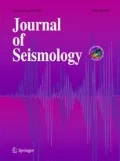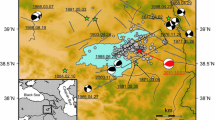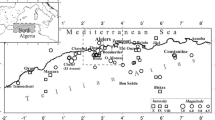Abstract
We analyzed the rupture process of the 2011 Mw7.1 Van, Eastern Turkey earthquake using teleseismic, strong-motion, 1-Hz GPS waveforms and static GPS displacement measurements. We performed data sensitivity analyses using four different rupture scenarios. Overall, when geodetic and seismic datasets are modeled jointly, slip distribution is well-constrained and rupture velocity can be obtained. The 2011 Van earthquake is a case where none of the available datasets are sufficient to constrain the slip distribution and the rupture kinematics on their own. This study confirms that rather than fitting one dataset perfectly, using multiple datasets jointly leads to a better-constrained slip distribution. The kinematic model obtained from the joint inversion of all the available data shows a 45-km-long bilateral rupture with two sub-events; one larger slip patch propagating up-dip and toward west of the hypocenter and a smaller second slip patch toward the east. The highest slip is to the west of the hypocenter with a peak value of 4.5 m. The slip is confined to the depths of 7.5 to 20 km and the shallower part of the fault remains unbroken. The average rupture velocity is around 3 km/s, close the Rayleigh wave velocity. The rupture is faster with shorter rise times for the larger sub-event toward the west, while the rise times are longer for the smaller sub-event to the east. This difference in seismic behavior might be related to the segmentation of the fault.












Similar content being viewed by others
References
Altiner Y, Sohne W, Guney C, Perlt J, Wang R, Muzli M (2013) A geodetic study of the 23 October 2011 Van, turkey earthquake. Tectonophys 588:118–134
Arpat E, Saroglu F (1972) The East Anatolian fault system: troughs on its development. Miner Res Explor Inst Turkey Bull 78:33–39
Avouac JP, Ayoub F, Leprince S, Konca O, Helmberger DV (2006) The 2005, Mw 7.6 Kashmir earthquake: sub-pixel correlation of ASTER images and seismic waveforms analysis. Earth Planet Sci Lett 249(3-4):514–528
Barka A (1992) The North Anatolian fault zone. Ann Tectonicae 6:164–195
Bassin C, Laske G, Masters G (2000) The current limits of resolution for surface wave tomography in North America. Eos Trans 81(48):S12A–03 (Fall Meet. Suppl.)
Choi K, Bilich A, Larson K, Axelrad P 2004) Modified sidereal filtering: implications for high-rate GPS positioning. Geoph Res Lett 31(L22608) doi:10.1029/2004GL021621
Delouis B, Giardini D, Lundgren P, Salichon J (2002) Joint inversion of InSAR, GPS, teleseismic, and strong-motion data for the spatial and temporal distribution of earthquake slip: application to the 1999 izmit mainshock. Bull Seismol Soc Am 92(1):278–299
Delouis B, J-M N, Vallee M (2010) Slip distribution of the February 27, 2010 Mw = 8.8 Maule Earthquake, central Chile, from static and high-rate GPS, InSAR, and broadband teleseismic data. Geoph Res Lett., 37(17), doi: 10.1029/2010GL043899
Dewey J, Hempton MR, Kidd WSF, Saroglu F, Sengor AMC (1986) Shortening of continental lithosphere: the neotectonics of Eastern Anatolia—a young collision zone. Geol Soc Lond Spec Publ 19(1):1–36
Dogan U, Demir DO, Cakir Z, Ergintav S, Ozener H, Akoglu AM, Nalbant SS, Reilinger R (2014. Postseismic deformation following the Mw 7.2, 23 October 2011 Van earthquake (Turkey): evidence for a seismic fault reactivation, Geoph Res Lett. 41, doi:10.1002/2014GL059291
Dziewonski AM, Chou T-A, Woodhouse JH (1981) Determination of earthquake source parameters from waveform data for studies of global and regional seismicity. J Geophys Res B86:2825–2852
Ekstrom G, Nettles M, Dziewonski AM (2012) The global CMT project 2004-2010: centroid-moment tensors for 13,017 earthquakes.Phys Earth Planet Inter 200-201, doi:10.1016/j.pepi.2012.1004.1002
Elliott JR, Copley AC, Holley R, Scharer K, Parsons B (2013) The 2011 Mw 7.1 Van (Eastern Turkey) earthquake. J Geophys Res
Emre O, Duman T, Ozalp S, Elmaci H (2011) Van depremi saha gözlemleri ve kaynak faya ilişkin Ön değerlendirmeler. Van earthquake Report, MTA
Evangelidis CP, Kao H (2013) High-frequency source imaging of the 2011 October 23 Van (Eastern Turkey) earthquake by backprojection of strong motion waveforms. Geophys Jour Int. doi:10.1093/gji/ggt1437
Fielding EJ, Lundgren PR, Taymaz T, Yolsal-Cevikbilen S, Owen SE (2013) Fault-slip source models for the 2011 M 7.1 Van earthquake in turkey from SAR interferometry, pixel offset tracking, GPS, and seismic waveform analysis. Seismol Res Lett 84(4):579–593
Gallovic F, Ameri G, Zahradnik J, Jansky J, Plicka V, Sokos E, Askan A, Pakzad M (2013) Fault process and broadband ground-motion simulations of the 23 October 2011 Van (eastern turkey) earthquake. B Seismol Soc Am 103(6):3164–3178
Hayes GP (2011) Finite Fault Model Updated Result of the Oct 23, 2011 Mw 7.1 Eastern Turkey Earthquake, in http://earthquake.usgs.gov/earthquakes/eqinthenews/2011/usb0006bqc/finite_fault.php, edited.
Herring T (1998). Documentation for GLOBK: Global Kalman filter for VLBI and GPS analysis program, version 4.1. Mass Inst Technol, Cambridge
Ji C, Wald D, Helmberger DV (2002) Source description of the 1999 Hector Mine, California earthquake, part I: wavelet domain inversion theory and resolution analysis. Bull Seismol Soc Am 92(4):1192–1207
Ji C, Helmberger D, Wald DM, Ma KF (2003). Slip history and dynamic implications of the 1999 Chi-Chi, Taiwan, earthquake. Journal of Geophysical Research-Solid Earth, 108(B9), Art. No. 2412
Ji C, Larson K, Hudnut K, Choi K (2004) Slip history of the 2003 San Simeon earthquake constrained by combining 1--Hz GPS, strong motion, and teleseismic data. Geophys Res Let 31, L17608
Konca AO, Hjorleifsdottir V, Song TRA, Avouac JP, Helmberger DV, Ji C, Sieh K, Briggs R, Meltzner A (2007) Rupture kinematics of the 2005 M-w 8.6 Nias-Simeulue earthquake from the joint inversion of seismic and geodetic data. Bull Soc Am 97(1):S307–S322
Konca AO, Avouac JP, Sladen A, Meltzner AJ, Sieh K, Fang P, Li Z, Galetzka J, Genrich J, Chlieh M, Natawidjaja DH, Bock Y, Fielding EJ, Ji C, Helmberger D (2008) Partial rupture of a locked patch of the Sumatra megathrust during the 2007 earthquake sequence. Nature 456:631–635
Konca AO, Kaneko Y, Lapusta N,Avouac JP (2013). Kinematic inversion of physically plausible earthquake source models obtained from dynamic rupture simulations. Bull Seismol Soc Am 103(5)
Larson K, Bodin P, Gomberg J (2003) Using 1-Hz GPS data to measure deformations caused by the Denali Fault earthquake. Science 300, doi: 10.1126/science.1084531
Moro M, Canelli V, Chini M, Bignami C, Melini D, Stramondo S, Saroli M, Picchiani M, Kriakopoulos C, Brunori CA (2014) The October 23, 2011, Van (Turkey) earthquake and its relationship with neighbouring structures, Sci. Rep., 4, doi: 10.1038/srep03959
Orgulu G, Aktar M, Turkelli N, Sandvol E, Barazangi M (2003) Contribution to the seismotectonics of Eastern Turkey from moderate and small size events. Geophys Res Lett 30(24), doi:10.1029/2003GL018258
Page MT, Custodio S, Archuleta RJ, Carlson JM (2009) Constraining Earthquake Source Inversions with GPS DATA 1: resolution based removal of artifacts. J Geophys Res 114(B01314). doi:10.1029/2007JB10005449
Razafindrakoto HBT, Mai PM (2014) Uncertainty in earthquake source imaging due to variations in source time function and earth structure. Bull Seismol Soc Am 104(2), doi: 10.1785/0120130195
Reilinger R, Mcclusky S, Vernant P, Lawrence S, Ergintav S, Cakmak R, Ozener H, Kadirov F, Guliev I, Stepanyan R, Nadariya M, Hahubia G, Mahmoud S, Sakr K, Arrajehi A, Paradissis D, Al-Aydrus A, Prilepin M, Guseva T, Evren E, Dmitrotsa A, Filikov SV, Gomez F, Al-Ghazzi R, Karam G (2006) GPS constraints on continental deformation in the Africa-Arabia-Eurasia continental collision zone and implications for the dynamics of plate interactions. J Geophys Res 111(B05411), doi:10.1029/2005JB004051
Saroglu F, Emre O, Kuscu I (1992) Active fault map of Turkey. General Directorate of Mineral Research and Exploration, Ankara
Sengor AMC, Yilmaz Y (1981) Tethyan evolution of Turkey: a plate tectonic approach. Techonophysics 75:181–241
Sengor AMC, Gorur N, Saroglu F (1985) Strike-slip faulting and related basin formation in zones of tectonic escape: Turkey as a case study, in The Society of Economic Paleontologists and Mineralogists, edited
Simons M, Fialko Y, Rivera L (2002) Coseismic deformation from the 1999 M-w 7.1 Hector Mine, California, earthquake as inferred from InSAR and GPS observations. Bull Seismolo Soc Am 92(4):1390–1402
Utkucu (2013) 23 October 2011 Van, Eastern Anatolia, earthquake (MW 7.1) and seismotectonics of Lake Van area, J Seismol, 17, 783-805
Wang GQ, Boore D, Tang G, Zhou X (2007) Comparisons of ground motions from colocated and closely spaced One-sample-per-second global positioning system and accelerograph recordings of the 2003 M 6.5 San Simeon, California, earthquake in the parkfield region. Bul Seismol Soc Am 97:76–90
Wang R, Parolai S, Ge M, Jin M, Walter TR, Zschau J (2013) The 2011 Mw 9.0 Tohoku earthquake: comparison of GPS and strong-motion data. Bull SeismSoc Am 103(2B);1336-1347
Yin H, Wdowindski S, Liu X, Gan WJ, Huang B, Xiao G, Liang S (2013 Strong ground motion recorded by high-rate GPS of the 2008 Ms 8.0 Wenchuan earthquake, China, Seis Res Lett
Zahradnik J, Sokos E (2014) TheMw 7.1 Van, Eastern Turkey, earthquake 2011: two-point source modelling by iterative deconvolution and non-negative least squares. Geophys J Int 196:522–538
Zhu L, Rivera LA (2001) Computation of dynamic and static displacement from a point source in multi-layered media. Geophys J Int 148(3):1634–1641
Zor E, Sandvol E, Gurbuz C, Turkelli N, Seber D, Barazangi M (2003) The crustal structure of the East Anatolian plateau (Turkey) from receiver functions. Geophys Res Lett 30(24) doi:10.1029/2003GL018192
Acknowledgments
This study was supported by Scientific and Technological Research Council of Turkey (TUBITAK) grant no: 112Y338. I would like to especially thank Prof. Semih Ergintav for the processing of the cGPS data. This manuscript has benefited greatly from the valuable comments of Dr. P. Martin Mai and one anonymous reviewer. I would like to thank Prof. Hayrullah Karabulut, Prof. Mustafa Aktar, and Dr. Yeliz Utku Konca for proofreading the manuscript.
Author information
Authors and Affiliations
Corresponding author
Rights and permissions
About this article
Cite this article
Konca, A.O. Rupture process of 2011 Mw7.1 Van, Eastern Turkey earthquake from joint inversion of strong-motion, high-rate GPS, teleseismic, and GPS data. J Seismol 19, 969–988 (2015). https://doi.org/10.1007/s10950-015-9506-z
Received:
Accepted:
Published:
Issue Date:
DOI: https://doi.org/10.1007/s10950-015-9506-z




